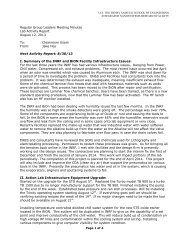Download Lab Safety Manual - Integrated Nanosystems Research ...
Download Lab Safety Manual - Integrated Nanosystems Research ...
Download Lab Safety Manual - Integrated Nanosystems Research ...
Create successful ePaper yourself
Turn your PDF publications into a flip-book with our unique Google optimized e-Paper software.
3.3 Other Hazards<br />
Many tools in the lab use or generate high voltages, ultraviolet, or electromagnetic radiation. <strong>Safety</strong> interlocks are<br />
built into each tool, which prevent direct high voltage sources or exposure to radiation sources during normal<br />
operation. However, no system is absolutely foolproof. It is absolutely essential that you, as a researcher, learn<br />
and are always aware of the potential hazards, and follow the procedures for safe operation of each tool you are<br />
qualified to use.<br />
• Ultraviolet Radiation<br />
Chance of exposure is clearly a risk in lithography, where high power UV lamps are used in the aligner and<br />
stepper tools. However, UV exposure is also a potential risk in plasma etch, plasma deposition, and sputter tools,<br />
where highly energized species are generated.<br />
• Electromagnetic Radiation<br />
Electromagnetic radiation is a hazard presented by equipment using RF (primarily plasma etch and plasma<br />
deposition tools.) If you have a pacemaker, be aware that RF sources are present in the lab. All equipment is<br />
shielded to prevent exposure; report any damage to shielding on the equipment or cables.<br />
• Cryogenic Hazards<br />
Cryogenic hazards are presented by liquid nitrogen (“LN2”), which is used in many areas of the lab, such as cryo<br />
pumps. Liquid nitrogen is 77 °K (196 °C below freezing) and can thus cause freezing burns. Do not handle liquid<br />
nitrogen unless your equipment training covers it. Always wear protective gear (thermally insulated gloves and<br />
goggles) when handling liquid nitrogen.<br />
4. Where to find Chemical <strong>Safety</strong> Information<br />
4.1 Chemical <strong>Lab</strong>els<br />
Each chemical storage container is required to have a label, provided by the manufacturer, which in addition to<br />
composition; it contains the following precautionary information:<br />
1. “Caution”, “Warning” or “Danger”, indicating<br />
an increase risk for potential hazard.<br />
2. One or more Statements of Hazard, which describe in more detail the hazard presented.<br />
3. Precautionary Measures<br />
4. First Aid or other information (this may not always be present on the label).<br />
Remember, only chemicals in their original containers will have these labels. Chemicals that have been dispensed<br />
for use or into other containers may not have this information. Since gases are supplied remotely, their label<br />
information will not be handy. As a qualified user, it is your responsibility to know the chemicals being used at<br />
your station, and the hazards posed by each.<br />
4.2 MSDS<br />
Chemical manufacturers and distributors are required by federal law to provide safety information for each<br />
product they sell. The Materials <strong>Safety</strong> Data Sheet (MSDS) contains information on general composition,<br />
9



